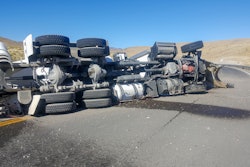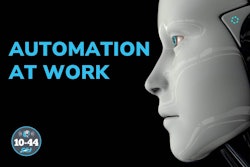Speaker 1 (00:00):
This week's 1044 is brought to you by Chevron Delo, 600 ADF Ultra Low Ash Diesel Engine Oil. It's time to kick some ash.
Jason Cannon (00:09):
Holidays are a dangerous time to be on the road for a lot of reasons. You're watching CCJ's 1044, a weekly episode that brings you the latest trucking industry news and updates from the editors of CCJ. Don't forget to subscribe and hit the bell for notifications, so you'll never miss an installment of 1044. Hey everybody, welcome back. I'm Jason Cannon and my co-host. On the other side is Matt Cole. Christmas is the time for good time and cheer unless you're out on the highway because more people on the roads leads to an annual drop in on road safety.
Matt Cole (00:41):
That drop starts to build just ahead of the holiday season as stores prep for the holiday rush, boosting inventories and the number of shipments they receive.
Jason Cannon (00:48):
All these trucks are put on the road with holiday vacationers and school and college aids kids that are out on winter break. But Gary Johnson, head of market strategy for Motive says "There's a bigger factor in play and one that affects all drivers above the Mason-Dixon line to a greater degree than those of us below it."
Jeffrey Short (01:06):
A key factor is the weather, and I tell you when I was in air freight my years, you could see real quick just that little weather pattern of what it would do to ripple effect, especially that freight movement. But we've also seen that obviously in the actual final mile of their trucking segment. We've seen during that period of let's say last year statistically that truck collisions almost doubled on just December 23rd itself. And when you really break that down, another factor was that December 23rd last year also saw 73% of accidents happen at locations that were impacted by snow, ice, or wet conditions. So, if memory serves me, if you go back, we had that weather system come through right before the holidays last year. Congestion is always going to play a big factor and we see congestion always fluctuating because of the holiday times and times up.
(02:08):
So, that will always be probably the biggest. But as a safety guy, as a safety professional, I would say that the one thing that always was the biggest contributing factor on statistics was always weather. We have sort of that influx of weather patterns that's going on today. You probably got sunshine, we're getting snow and rain up here. So for me, I always say the significant impact that I've seen statistically has always been on weather fluxes, but congestion is always going to be that what I'd say always a concern because of just the increase in traffic path.
Matt Cole (02:49):
The weather itself isn't always the driving factor for this degradation and safety. Gary says, "Some of it is attributed to not being able to drive in poor weather, and the need to make up for lost time when the weather does finally break."
Jeffrey Short (03:01):
Especially in freight movement, any of that type of disruption, then you get this demand or this feel that I got to get back out there when the roads are open. So, our statistics show 14% increase in speeding events, increase in hours of service violations. So, it's always a ripple effect and that's something you got to manage throughout that process because at the end of the day you're trying to get the retail going. So, there's a lot of factors obviously in the safety world when we talk about when it comes to this peak time. But when you throw those variables into it, I tell you it can really raise havoc and that's where you see the increase of these numbers when it comes to safety.
Jason Cannon (03:46):
Late model trucks come flush with all kinds of safety features which are designed to reduce crashes and improve safety. So, why do we see these fluctuations and crashes at all? Gary tells us after a word from 1044 sponsor Chevron lubricants.
Speaker 1 (04:01):
Protecting your diesel engine and its aftertreatment system has traditionally been a double-edged sword. The same engine oil that is so essential to protecting your engine's internal parts is also responsible for 90% of the ash that is clogging up your DPF and upping your fuel and maintenance costs. Outdated industry thinking still sees a trade-off between engine and emission system protection and Chevron was tired of it. So, they spent a decade of R&D developing a no compromise formulation.
(04:25):
Chevron lubricants developed a new ultra low ash diesel engine oil that is specifically designed to combat DPF ash clogging. Delo 600 ADF with Omnimax technology cuts sulfate ash by whopping 60%, which reduces the rate of DPF clogging and extends DPF service life by two and a half times. And just think what you can do with all the MPGs you're going to add from cutting your number of regions. But Delo 600 ADF isn't just about after treatment. It provides complete protection extending drain intervals by preventing oil breakdown. Before you had to choose between protecting your engine or your after treatment system and now you don't 600 ADF from Delo with Omnimax technology, it's time to kick some ash.
Jeffrey Short (05:07):
I'm old enough that I was in this industry starting this industry when there is no technology and clearly in my opinion, that was sort of a different approach to safety. And clearly throughout the years we've seen the explosion in safety technology. But the biggest part of that technology that I think is a concern today is people don't know what to do with the data. It really comes down to behavioral. We're trying to get to the behavior and being predictive in this analytics. We want to be predictive in trying to address these. It's there, but I think there's two arguments here. Motive, we also did a Data Safety 2023. It was a survey report that was done earlier in the year and it really honed in on surveying about 1,100 clients of just shy of a million vehicles of fleets that we surveyed across the board.
(06:06):
And we always asked them a couple of key factors in that report was first one, where do you see safety in organization? And 95% of those surveyed said yes, it's a priority. It's absolutely a priority. But the very second question was in 2023, what are your top three priorities then? And safety was third. So, then when you further on these statistics and you look at the surveyed questions, we would get to technology and especially on the dash camera systems and it was surprisingly how many do not invest or had not invested into the systems but yet alone. It was the reasons, it was reasons that I could go back to the early eighties when I started were reasons for not doing certain things. So, when we talk about adoption of technology, I think there's still this, it's a nice to have in a lot of people's mindset versus they see the benefits of the return on investment.
Matt Cole (07:06):
It may come as a surprise, but Gary says 'There are plenty of examples that show some of a given fleet's longest tenured drivers have some of the poorest safety habits."
Jeffrey Short (07:15):
It all comes down to that false sense of security. So for example, why do a lot of professional drivers not wear their seat belts? It's because I'm in a big vehicle, I'm not going to have that issue. Why does statistically fatal type crashes or critical crashes increase with the years of service? It's a false sense, a belief of what they can do and what this truck is capable or the vehicle is capable. So, there's a lot of times when we put dash cameras into clients, some of their big offenders with behaviors is their million mile of drivers because there's a false sense there.
Jason Cannon (07:56):
A key to successfully deploying safety tech is making sure that drivers have a clear understanding of what their truck is and is not equipped with and how it all works.
Jeffrey Short (08:05):
It is amazing to see when you have ADAS type systems. So, when you have these vehicle systems, when you put a dash camera in there, what is the first thing you see? You see a driver not touching their systems or their brakes with adaptive cruise because they will wait for the system to kick in to slow them down versus them taking the proactive approach of actually stopping it or cruise control. Let's talk about just something as simple as cruise control. When you have these weather events, one of the worst things you can ever do is have cruise control on. Cruise control takes away that vehicle control and with any type of icy conditions, you're going to lose traction. That's why you see it in the motor and public so bad. But also the thing about cruise control that you always have to worry about is that evenings. Fatigue, especially during those circadian rhythm type concerns of the hours, cruise control actually causes more fatigue because there's no control of the vehicle.
(09:15):
So, now you add all these other technologies, you really do, and this is where I caution a lot of clients and a lot of safety professionals. You have to get out and you have to explain during an orientation or the adoption of a new piece of equipment, of exactly the capabilities. Braking systems don't eliminate it, it mitigates it, meaning it tries to minimize. But if you have a stopped vehicle and someone is not even touching the controls, you're going to contact the vehicle. It's just as simple as that. So, there is a false belief on certain controls. Heck, I have that when I rent vehicles and it's all on there. You just don't realize it. So, ultimately at the end of the day, you got to be fully aware of the capabilities, what it can and can't do because in that safety ecosystem, the human machine and the environment, the human has to understand what that machine will do. And if you don't, then you're going to see a false belief of the capabilities. So, you're exactly right, it's very much a concern.
Jason Cannon (10:27):
That's it for this week's 1044. You can read more on CCJdigital.com. While you're there, sign up for our newsletter and stay up to date on the latest in trucking industry news and trends. If you have any questions or feedback, please let us know in the comments below. Don't forget to subscribe and hit the bell for notifications so you can catch us again next week.











